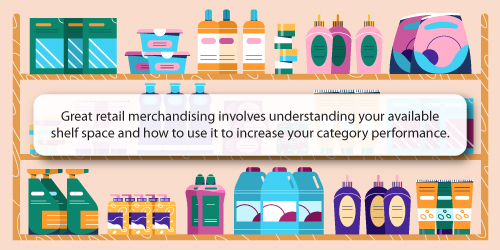The word 'merchandising' seems straightforward. If you're in retail, a simplistic way of explaining merchandising is to say it's how you pack out your shelves and displays so that your customers can see your products and purchase them. Of course, retail merchandising* is a little more complicated than that.
When it comes to merchandising your store, it's not only about packing your shelf. That forms part of it, yes. In reality, though, there is more opportunity for strategic intent.

It involves knowing what products sell well and which don't so you stock your shelves appropriately. Getting that right encourages repeat visits from customers. It also leads to customer loyalty, increased brand reputation and more money in the bank.
 Do your retail merchandising and space planning efforts need to connect?
Do your retail merchandising and space planning efforts need to connect?
Strategically presenting products in a retail space helps you create a unique store identity and a convenient shopping experience for your customers.
As for the relationship between retail merchandising and space management, it's simple: they are linked intrinsically to the overall performance of your store.

Without strategic space planning, you can't expect to merchandise your store effectively. Conversely, you can create the best planogram possible. However, if you don't merchandise your shelf or implement it as per the planogram, any efforts are in vain.
That's not to be a scaremonger but rather to explain the reality. If you want to please shoppers and maximise your sales, it's critical to understand the relationship between retail merchandising and space planning.
Effective space planning requires knowledge and in-depth analysis of the data behind every product in your store. Why? Because any decisions you make about your shelf space and what items to place must rely on your data.
Let's say, for example, you want to increase your sales. One way of achieving that would be to ensure the amount of space a product occupies on the shelf relates to the number of sales it generates. If the particular product represents 15% of your category sales, it should receive the appropriate space on the shelf. It applies to all products on the shelf.
Of course, there are several factors to consider, including unit costs, profit margin and more. You need to also acknowledge them before making any final space allocation decisions.
If you're the one building planograms for in-store implementation, you can't show favouritism to any brand. Do that, and there are dire consequences for everyone. Let's say you're a supplier and the category captain.
- Your retail client will implement the planogram, giving too much space to the wrong products, and too little to the items that deserve the shelf space.
- Your reputation and relationship with your retail client will suffer because you've given incorrect information, while the category will suffer financially. That includes sales for the products you supply.
- Your customers won't find what they want, becoming frustrated, which could cause them to leave without buying anything. They'll also think twice about visiting the store when they shop for that particular product.
It all speaks to one point - there is a balance you need to find to ensure that any of your efforts - be it on the space planning or retail merchandising side - work together to help you achieve your goals.

How do merchandising principles affect your space planning efforts?
Before building any planogram, you need to know the various merchandising principles and rules. These principles are, of course, not decided by one person - yourself. Instead, it's a team decision and depends on who you are working with and what goals you want to achieve.
There are two reasons for this:
- If you're a retailer, it helps you understand what your shelves should look like once you implement a planogram in-store.
- If you're the one building the planogram, agreeing on the principles beforehand prevents unnecessary time wastage that might come from going back and forth trying to decide on the final layout.
Of course, that doesn't mean there shouldn't be any collaboration. There should. In this case, it's more about agreeing on guiding principles to complete a planogram before making tweaks at a later stage.
When it comes to merchandising principles, there are over a dozen different ones available to you. They're all very much based on, among other things, your category role, your retail strategy and the suitability of your retail fixtures.
That said, here are a few basic principles around spacing specifically to be mindful of when creating your next planogram:
- There should be a 2.5cm height minimum between the highest point of your product and the underside of the shelve above it.
- The gap between your product's highest point and the shelf above it should be even across each drop.
- Always have a minimum of two facings for new products.
- Place your heavier and larger products at the bottom of your shelf because it's easier for your customers to reach them without injuring themselves.
- Never place shelves so close together that an upper shelf hides binned or boxed merchandise on the shelf below it.
- Place your high-profit margin products at eye level (or as near as possible) to increase your profits.
- Merchandise your house brands between your brand leaders and secondary brand.
It's also important to be aware of your shelf capacity to avoid congestion. No rule states how much merchandise to place on your shelf. However, never aim for maximum congestion, as it can lead to a poor shopping experience for your customers.
Instead, focus on the ideal congestion percentage - the balance between visual impact and product range.

Where do data-driven space planning and retail merchandising meet?
Without data, your planogram holds very little power.
In reality, a planogram without data is nothing but a pretty picture. We've unpacked this topic multiple times across our blog - we even have an entire section dedicated to retail data. But what type of data do you need to ensure?
Firstly, it's worth pointing out that planograms require data so that you can draw up a visual representation of your shelf and determine product space allocation and positioning.

More than that, for your space planning and retail merchandising to meet, the data you require includes:
- Sales data: You need information about monetary sales and the number of units sold over a specific period. Your sales history also helps you understand what's selling and when so you can meet demand.
- Category hierarchy: Aligning internally around your category role can help you understand how your shoppers behave. It also affects product positioning on the shelf.
- A range: You need to know your product assortment and ensure it matches the category, its role and the goals you want to achieve.
- SKU information: Having access to product classifications, images, dimensions, brand descriptions and more enables you to know everything there is to know about the items on your shelf.
- Product attributes: This information includes brand, size, colour, function and price. These attributes enable you to understand your consumer decision tree and shopper behaviour and how to arrange your products on the shelf for maximum visibility and sales.
- Fixture information: By knowing everything there is to know about the retail shelves in your store, you can better arrange your products and know your limitations if any. This information includes fixture types (shelves, hanging bars, pegs, baskets) and fixture dimensions (floor to shelf height and the height, width and depth of each shelf).
There is also enough evidence to back up any argument about using data to help you gain a competitive advantage.
But it's critical not to forget about category management software. Why? Category management software is an essential tool to host your data to generate performance-enhancing planograms while also assisting you in presenting your products on the shelf to maximise your sales and please shoppers.
After all, space planning references your data-driven aspects of merchandising. That data allows for an analytical outlook of what to present when merchandising.

Conclusion
While you might want to approach retail merchandising and space planning separately, that's not a good idea.
You need data to build effective planograms. With these data-driven planograms, your merchandisers can be confident in placing the products where they need to be on the shelf. That means customers can find what they want and leave your store satisfied.
However, if you remove any part of the above equation, it all breaks down.
Are you looking to maximise the potential of your selling space and please your customers? Why not book a custom complimentary consultation with a DotActiv expert today or browse through our various services and software editions on our online store?
*This article was updated on Tuesday, 25 October 2022.


